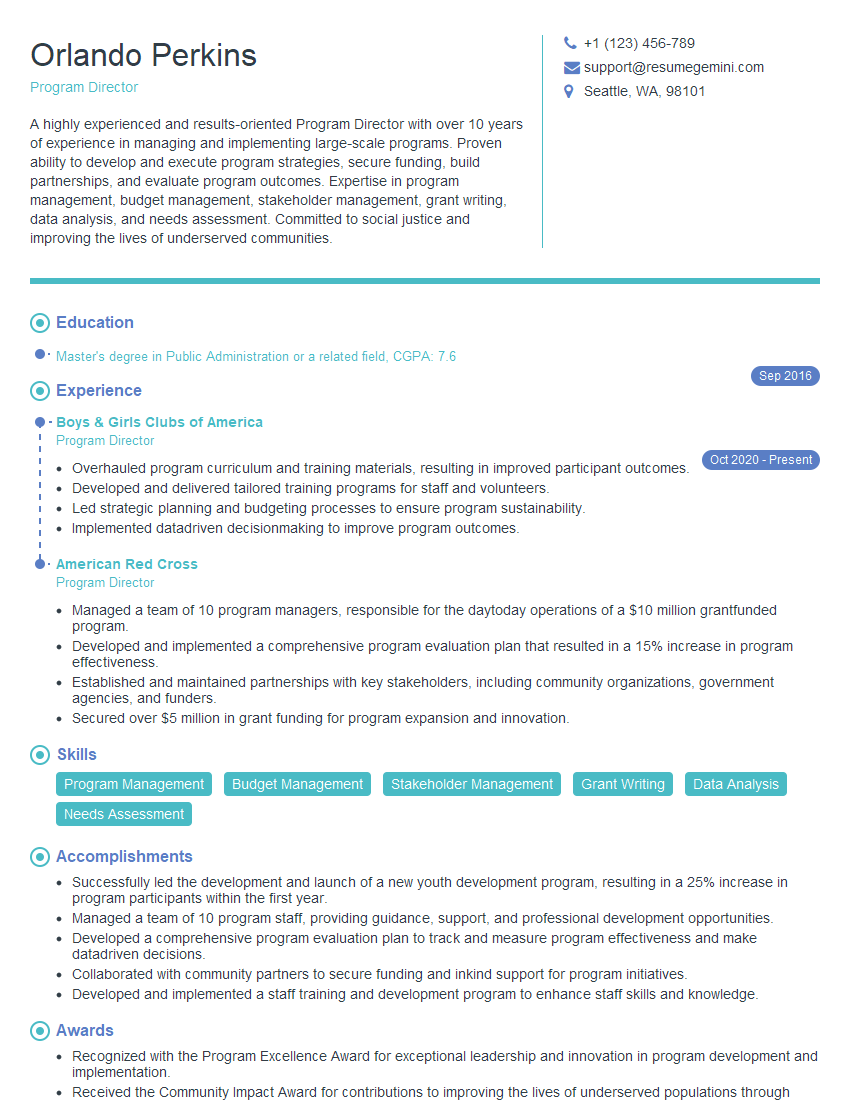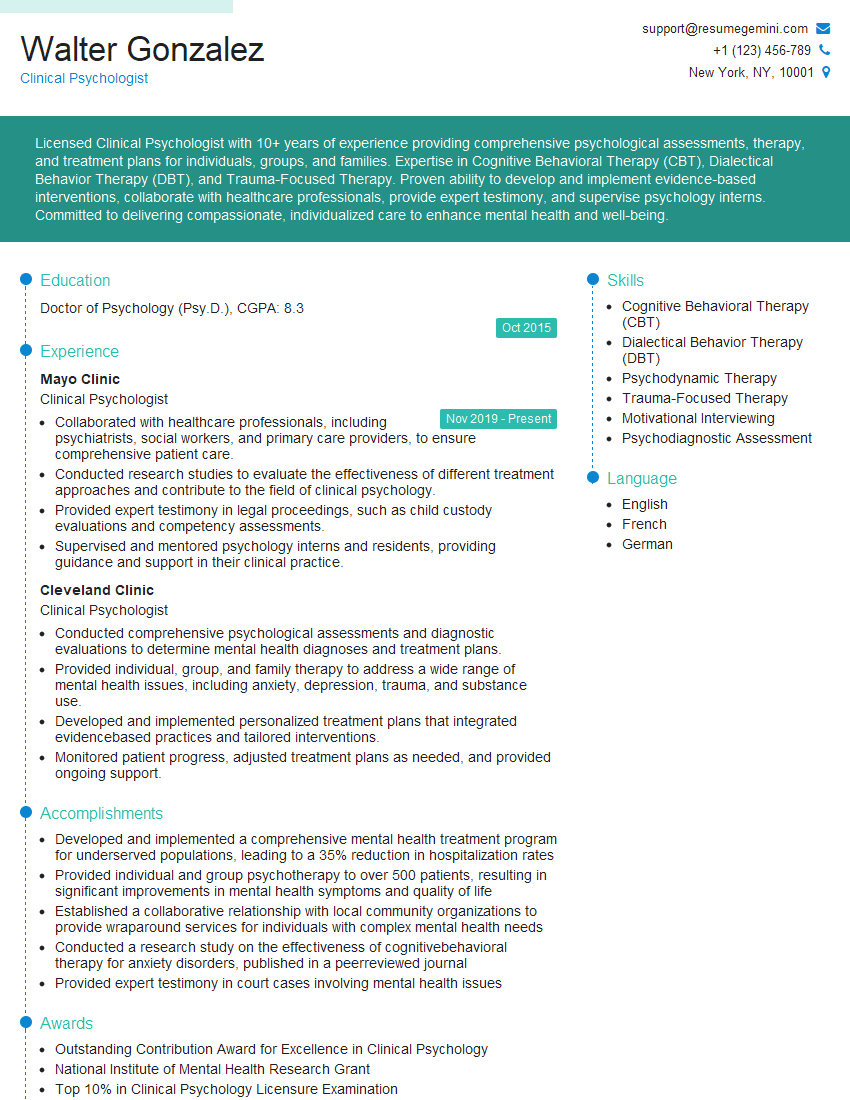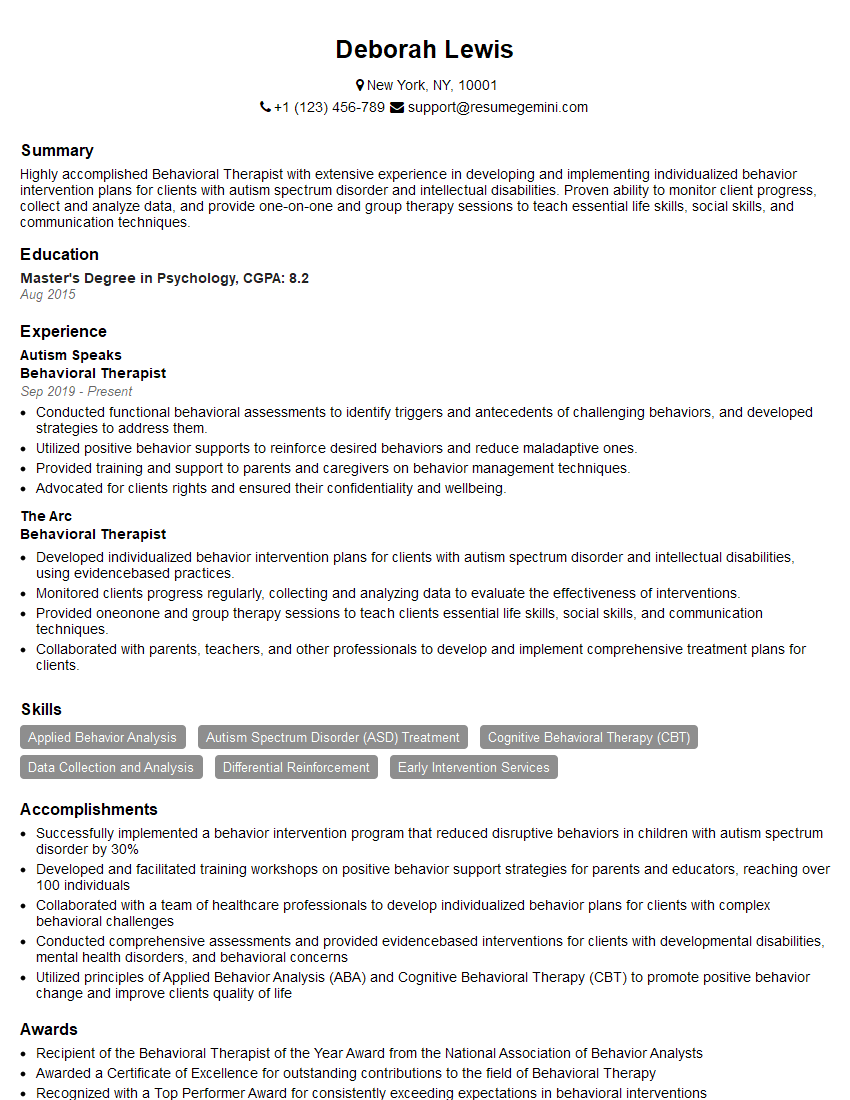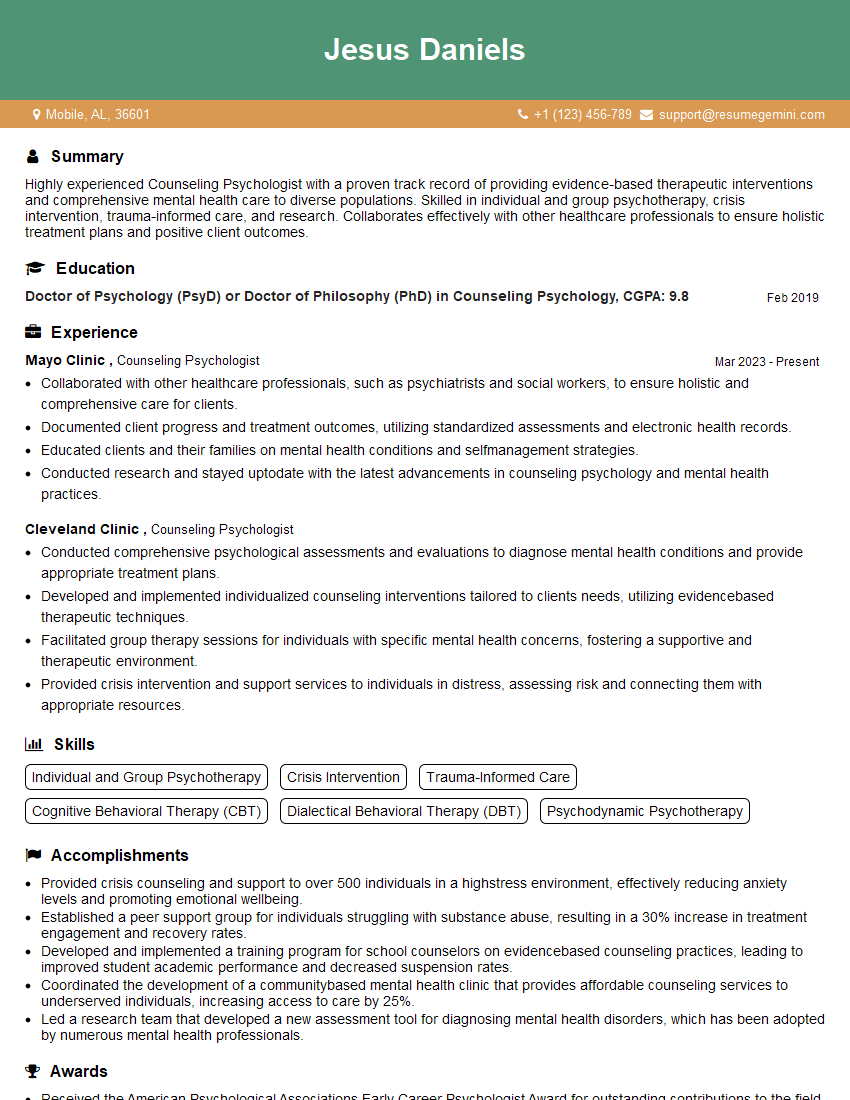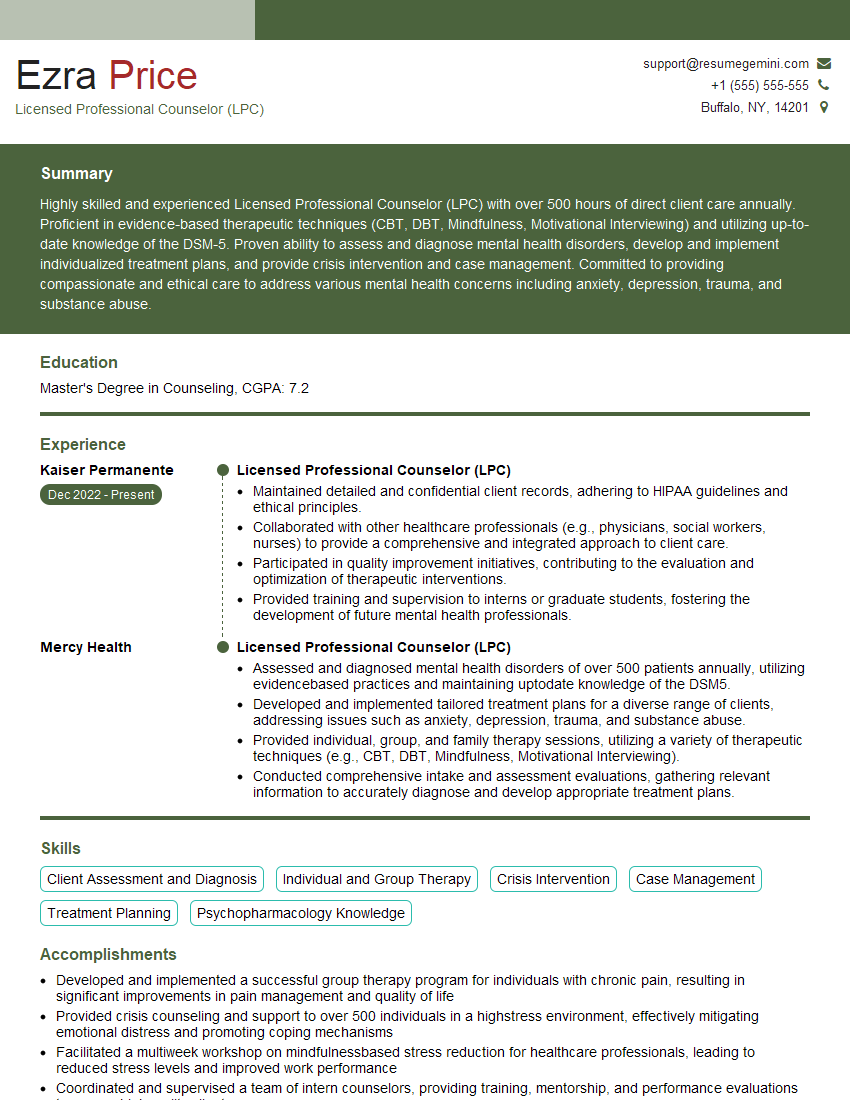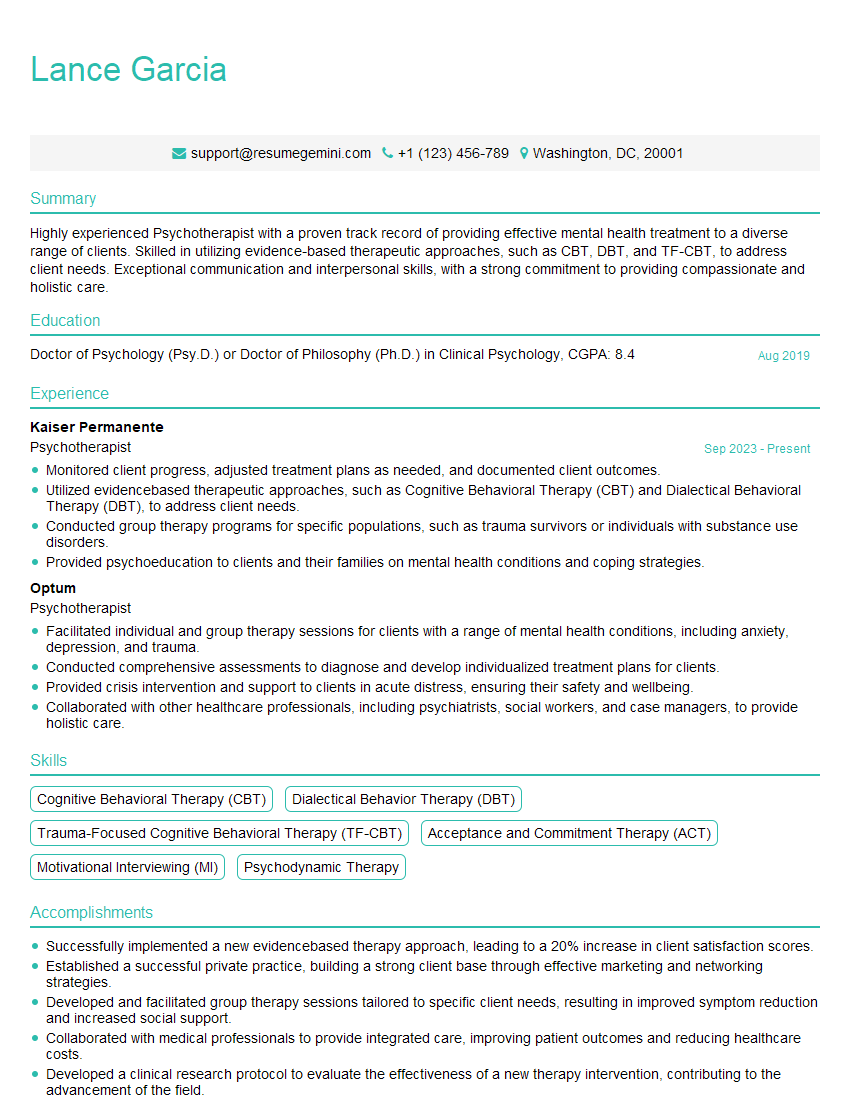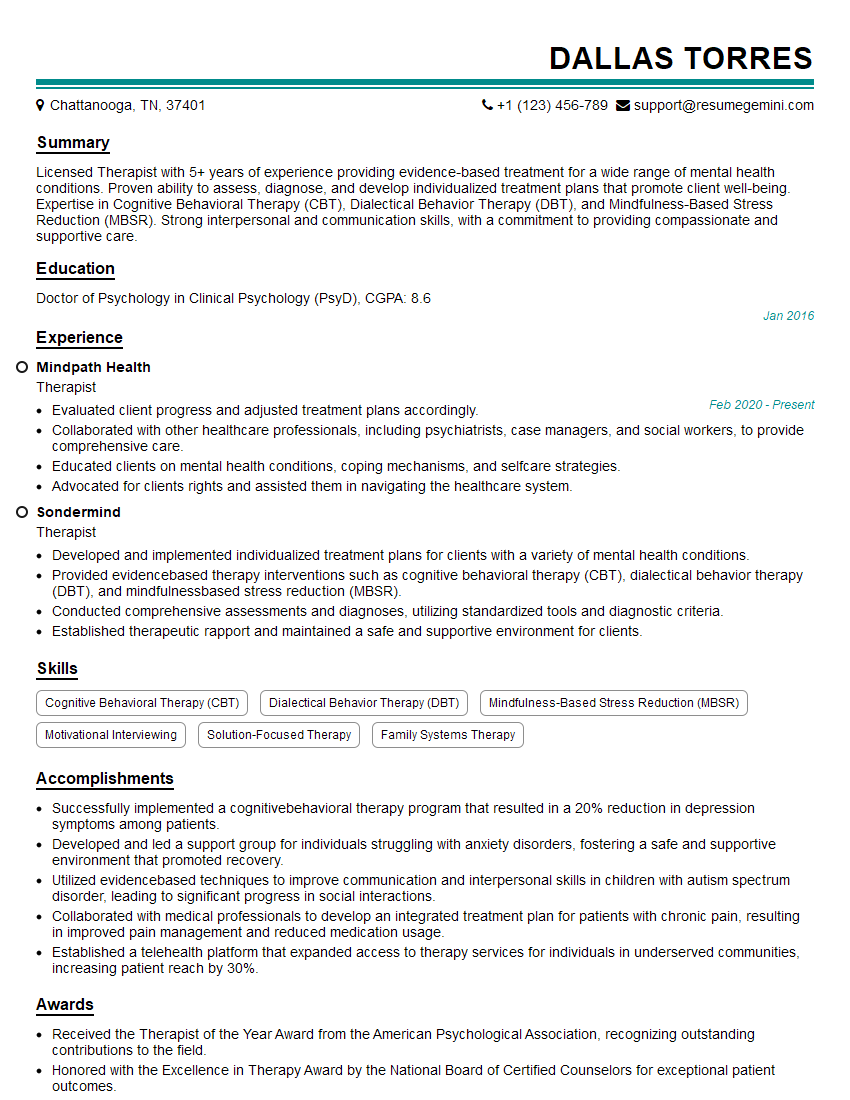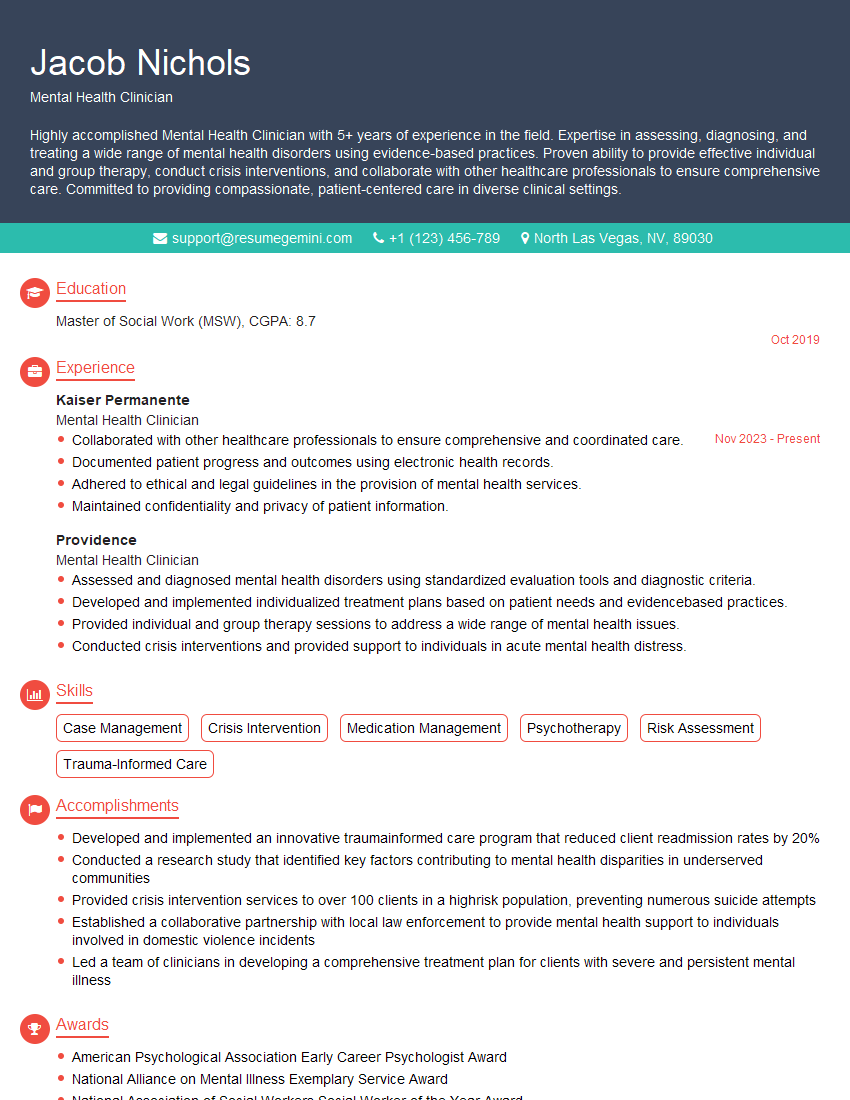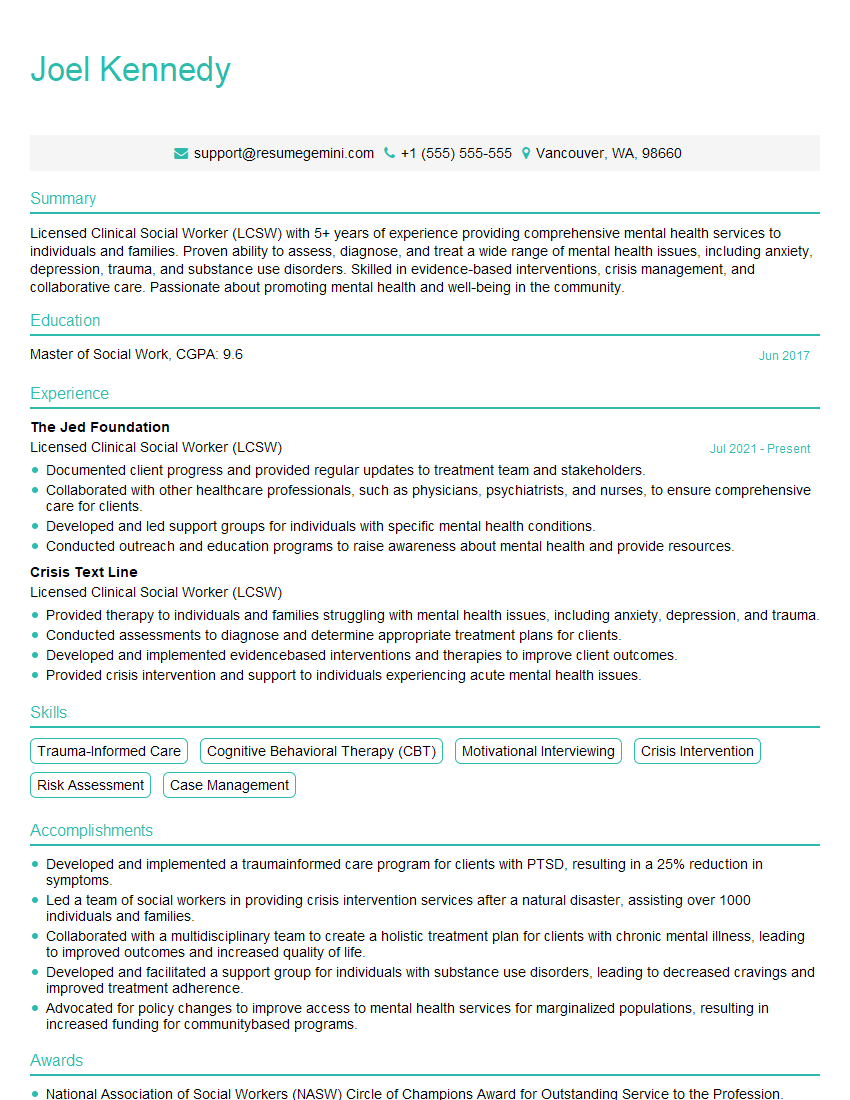Preparation is the key to success in any interview. In this post, we’ll explore crucial Panic Disorder Treatment interview questions and equip you with strategies to craft impactful answers. Whether you’re a beginner or a pro, these tips will elevate your preparation.
Questions Asked in Panic Disorder Treatment Interview
Q 1. Describe your experience utilizing Cognitive Behavioral Therapy (CBT) for Panic Disorder.
Cognitive Behavioral Therapy (CBT) is the gold standard treatment for Panic Disorder. My experience shows it’s incredibly effective because it directly tackles the core issues: maladaptive thoughts and behaviors that fuel panic. We start by identifying panic triggers and the specific thoughts and physical sensations associated with them. For instance, a patient might fear a rapid heartbeat, interpreting it as a heart attack. CBT helps reframe this catastrophic thinking. We’d explore alternative explanations – perhaps exertion, caffeine, or anxiety itself – and gradually challenge the fear-based interpretations. Then, we develop coping mechanisms, like relaxation techniques (deep breathing, progressive muscle relaxation) to manage physical symptoms and cognitive restructuring techniques to challenge negative thoughts in real-time. This isn’t a quick fix; it involves homework, practice, and consistent effort, but the results are transformative. I often use cognitive restructuring techniques like Socratic questioning to help patients identify and challenge their own distorted thinking. For example, if a patient says ‘I’m going to die,’ I’ll ask, ‘What evidence supports that thought?’ This helps them see the irrationality of their fears.
We also work on behavioral experiments. Perhaps a patient avoids crowded places. Through gradual exposure in a safe and controlled environment, they learn their feared situations aren’t inherently dangerous. Their progress is monitored, and we adjust the therapy as needed, making it a personalized journey.
Q 2. Explain the role of exposure therapy in treating panic attacks.
Exposure therapy is a crucial component of CBT for panic disorder. It involves gradually and repeatedly exposing the patient to the situations, objects, or thoughts that trigger panic attacks. The goal is to desensitize the patient to these triggers, demonstrating that the feared outcome (e.g., a heart attack) is unlikely to occur. It’s not about eliminating fear entirely; it’s about learning to manage it. We start with less anxiety-provoking situations and gradually work our way up to more challenging ones. This process, often called a hierarchy of fear, is created collaboratively with the patient. It might involve imagining the feared situation, actually experiencing it in a controlled setting, or even role-playing. For example, someone with agoraphobia (fear of open spaces) might start by walking around their block and gradually increase the distance over several sessions. This is done in a supportive therapeutic environment, and patients learn coping strategies to manage the anxiety that inevitably arises. The success of exposure therapy relies heavily on the therapeutic relationship and careful planning and adaptation based on the patient’s response.
Q 3. How do you differentiate between panic disorder and other anxiety disorders?
While panic disorder and other anxiety disorders share symptoms like worry and fear, key distinctions exist. Panic disorder is characterized by recurrent, unexpected panic attacks – sudden surges of intense fear or discomfort that reach a peak within minutes. These attacks aren’t tied to a specific object or situation, unlike phobias. Generalized Anxiety Disorder (GAD) involves persistent, excessive worry about various things, lasting at least six months. Social Anxiety Disorder (SAD) centers on fear of social situations and scrutiny. Specific phobias involve intense fear of a particular object or situation. Post-Traumatic Stress Disorder (PTSD) stems from a traumatic experience. The crucial difference lies in the nature and pattern of symptoms. Panic disorder is defined by the unexpected, intense panic attacks. A person with GAD may experience anxiety, but not the discrete, intense panic attacks characteristic of panic disorder. A proper diagnosis requires a comprehensive clinical assessment to differentiate these conditions.
Q 4. What are the common pharmacological treatments for Panic Disorder, and when would you consider them?
Selective Serotonin Reuptake Inhibitors (SSRIs) and Serotonin-Norepinephrine Reuptake Inhibitors (SNRIs) are the first-line pharmacological treatments for panic disorder. They work by increasing the levels of serotonin and/or norepinephrine in the brain, which are neurotransmitters involved in mood regulation. Examples include paroxetine, sertraline (SSRIs), and venlafaxine (SNRI). Benzodiazepines, like alprazolam, are sometimes used for short-term relief of severe symptoms due to their rapid onset of action, but their long-term use can lead to dependence and withdrawal symptoms. Therefore, they are generally not a first-line treatment, and their use is carefully considered. I would consider pharmacological treatment when symptoms are significantly impairing a patient’s daily life, despite adequate psychotherapy, or when the patient is experiencing intolerable symptoms. The choice of medication, dosage, and monitoring are individualized based on the patient’s needs, response, and potential side effects.
Q 5. Describe your approach to assessing the severity of a patient’s panic disorder.
Assessing the severity of a patient’s panic disorder involves a multi-faceted approach. I begin with a thorough clinical interview, exploring the frequency, intensity, and duration of panic attacks. I also assess the impact of panic attacks on the patient’s daily functioning (work, relationships, social life). Standardized questionnaires, like the Panic Disorder Severity Scale (PDSS) or the Anxiety Sensitivity Index (ASI), provide objective measures. The ASI is particularly useful as it assesses the extent to which individuals fear the physical sensations associated with anxiety. Additionally, I explore the presence of avoidance behaviors, which are crucial in gauging the level of disability caused by the disorder. For example, a patient might avoid driving because of fear of having a panic attack. The combination of clinical interview, standardized questionnaires, and behavioral observation paints a comprehensive picture of the severity of the disorder, which then guides treatment planning.
Q 6. How do you manage resistance to treatment in a patient with panic disorder?
Resistance to treatment is common in panic disorder, often stemming from fear, lack of understanding, or previous negative experiences. My approach involves building a strong therapeutic alliance based on empathy, trust, and collaboration. I start by validating the patient’s feelings and acknowledging the difficulties they’re facing. We work together to understand the reasons for their resistance. Is it fear of exposure therapy? Concerns about medication side effects? A lack of faith in therapy’s effectiveness? Once the root of the resistance is understood, we collaboratively adjust the treatment plan to address these concerns. For example, if a patient resists exposure therapy, we might start with very gradual exposure, offering plenty of support and control. If medication is causing side effects, we work to manage them or adjust the medication. If they are doubtful of the effectiveness, I share success stories and provide evidence-based information. Ultimately, it’s about empowering the patient to participate actively in their recovery, which means considering their perspectives and customizing the treatment.
Q 7. What are the key components of a comprehensive treatment plan for Panic Disorder?
A comprehensive treatment plan for panic disorder integrates several key components. Firstly, a thorough assessment is crucial to establish a diagnosis and understand the patient’s individual needs. Secondly, Psychotherapy, primarily CBT, including exposure therapy and cognitive restructuring, forms the cornerstone of treatment. Thirdly, pharmacological interventions like SSRIs or SNRIs might be incorporated depending on the severity and response to psychotherapy. Fourthly, relaxation techniques, such as deep breathing exercises, progressive muscle relaxation, and mindfulness meditation, are essential tools for managing anxiety symptoms. Fifthly, regular monitoring and follow-up sessions are essential to track progress, adjust treatment as needed, and address any challenges that may arise. Sixthly, psychoeducation for the patient and their family is crucial to increase understanding of the disorder and promote adherence to treatment. Finally, collaborative goal setting and ongoing support are key factors that facilitate long-term recovery and prevent relapse.
Q 8. How do you incorporate relaxation techniques into your Panic Disorder treatment?
Relaxation techniques are crucial in panic disorder treatment because they directly counteract the physiological symptoms of panic attacks – rapid heart rate, shortness of breath, trembling etc. I integrate several evidence-based techniques, tailoring them to each patient’s preferences and abilities.
Diaphragmatic breathing (or belly breathing): This slows the heart rate and reduces feelings of breathlessness. I guide patients through exercises, emphasizing proper technique and practicing regularly, even outside therapy sessions.
Progressive muscle relaxation: This technique involves systematically tensing and releasing different muscle groups to reduce overall muscle tension, a common feature of anxiety. I often use audio-guided exercises to aid in this process.
Mindfulness meditation: This helps patients focus on the present moment, reducing rumination about the future or worries about past panic attacks. I introduce different mindfulness techniques, like body scan meditation, to help them develop this skill.
Guided imagery: Patients create or are guided through calming and relaxing mental images. This can be particularly effective in reducing anxiety related to specific triggers or situations.
The key is consistent practice. I encourage patients to integrate these techniques into their daily routines, viewing them as self-help tools readily available during moments of anxiety.
Q 9. Explain your understanding of the cognitive model of panic disorder.
The cognitive model of panic disorder posits that panic attacks aren’t simply caused by physiological changes, but also by the way individuals interpret these changes. It emphasizes the role of catastrophic misinterpretations of bodily sensations.
Imagine someone experiencing a slightly increased heart rate. A person without panic disorder might attribute it to exercise or stress. However, someone prone to panic might interpret this as a sign of an impending heart attack or other catastrophic event. This misinterpretation fuels further anxiety, leading to a full-blown panic attack. This is often referred to as the ‘fear of fear’.
This model focuses on identifying and challenging these negative automatic thoughts (NATs) and cognitive distortions like overgeneralization or all-or-nothing thinking. Therapy then focuses on helping patients develop more balanced and realistic interpretations of bodily sensations, thereby reducing their fear response.
Q 10. How do you address comorbid conditions alongside panic disorder?
Panic disorder frequently co-occurs with other mental health conditions, often referred to as comorbidity. Common examples include depression, generalized anxiety disorder (GAD), social anxiety disorder, PTSD, and substance abuse disorders.
My approach involves a comprehensive assessment to identify all co-occurring conditions. Treatment is then tailored to address these issues simultaneously, rather than treating them in isolation. This might involve a combination of psychotherapy (like Cognitive Behavioral Therapy – CBT – or other evidence-based approaches) and medication, adjusted based on the patient’s needs. For instance, if a patient has both panic disorder and depression, the treatment plan may include medication targeting both conditions and CBT addressing both the catastrophic thinking related to panic and negative thought patterns related to depression.
Collaboration with other healthcare professionals like psychiatrists or addiction specialists is often crucial to ensure comprehensive and effective treatment.
Q 11. Describe a case where you successfully treated a patient with panic disorder. What were the key interventions?
I recall a patient, Sarah, who presented with severe panic attacks multiple times a week, often triggered by crowded places or social situations. She was avoiding many aspects of her life, severely impacting her social life and work. She reported intense fear of losing control or dying during attacks.
Our treatment focused on several key interventions:
CBT: We used exposure therapy, gradually exposing Sarah to feared situations (starting with less anxiety-provoking ones) while utilizing coping mechanisms she learned, like deep breathing and cognitive restructuring to challenge her catastrophic thinking.
Relaxation techniques: We incorporated progressive muscle relaxation and mindfulness meditation into her daily routine.
Panic control therapy (PCT): This involved psychoeducation about panic attacks, identifying early warning signs, and practicing specific techniques to manage them.
Over several months, Sarah’s panic attacks gradually reduced in frequency and intensity. Her avoidance behaviors also decreased significantly. Key to her success was her active participation, consistent practice of learned skills, and ongoing self-monitoring.
Q 12. What are the potential side effects of common medications used to treat panic disorder?
Common medications used to treat panic disorder, primarily selective serotonin reuptake inhibitors (SSRIs) and serotonin-norepinephrine reuptake inhibitors (SNRIs), can have side effects. These can vary from person to person, but common ones include:
Nausea
Headaches
Drowsiness
Weight changes
Sexual dysfunction
Insomnia or sleep disturbances
These side effects are often mild and temporary, but it’s crucial to discuss them openly with the prescribing physician. Adjusting dosage or switching medication might be necessary in some cases. It’s also important to be aware of potentially more serious but less frequent side effects, and to immediately seek medical attention if any concerning symptoms arise.
Q 13. How do you monitor treatment progress in patients with panic disorder?
Monitoring treatment progress is an ongoing process, not a one-time event. I utilize several methods:
Regular sessions: We discuss symptom frequency, intensity, and duration of panic attacks and the level of functional impairment.
Self-report measures: Standardized questionnaires, like the Panic Disorder Severity Scale (PDSS), provide quantifiable data to track improvement over time.
Behavioral monitoring: Patients track their panic attacks and their triggers in a journal or app. This helps identify patterns and monitor the effectiveness of interventions.
Functional assessment: We regularly assess the impact of panic disorder on daily life, such as work, relationships, and social activities. Improvements in these areas are key indicators of successful treatment.
This multifaceted approach offers a comprehensive understanding of the patient’s progress, allowing for adjustments to the treatment plan as needed. Open communication and regular feedback from the patient are essential.
Q 14. How do you adapt your treatment approach for different age groups or cultural backgrounds?
Adapting treatment to different age groups and cultural backgrounds is crucial for effective care. Treatment needs to be sensitive to developmental stages and cultural norms.
Age groups: For children and adolescents, therapy often involves family involvement and uses age-appropriate techniques like play therapy or expressive arts therapies. With older adults, consideration must be given to physical health conditions and potential medication interactions.
Cultural backgrounds: Cultural beliefs and attitudes toward mental illness significantly impact help-seeking behaviors and treatment adherence. I ensure that treatment is culturally sensitive by considering potential cultural barriers, utilizing interpreters when needed, and adapting therapeutic techniques to align with cultural values and perspectives. It is vital to understand that what constitutes a ‘panic attack’ might be viewed and described differently across cultures. Working collaboratively with the patient to ensure understanding and cultural competency in the therapeutic process is key.
A flexible and individualized approach is essential to effectively address the unique needs of diverse patient populations.
Q 15. What are the signs and symptoms of a panic attack?
Panic attacks are sudden episodes of intense fear that typically peak within minutes. They’re characterized by a range of physical and psychological symptoms that can be incredibly distressing.
- Physical Symptoms: These can include rapid heartbeat (tachycardia), sweating, trembling or shaking, shortness of breath or feeling like you’re choking, chest pain or discomfort, nausea or abdominal distress, dizziness, feeling lightheaded or faint, chills or hot flashes, numbness or tingling sensations (paresthesia), and feeling detached from oneself or one’s surroundings (derealization or depersonalization).
- Psychological Symptoms: These involve intense fear or apprehension, a sense of impending doom or catastrophe, fear of losing control or going crazy, and fear of dying.
It’s crucial to remember that the intensity and combination of symptoms vary greatly from person to person. One individual might experience predominantly physical symptoms, while another might focus more on the psychological aspects. The key is the sudden onset and overwhelming feeling of intense fear.
Career Expert Tips:
- Ace those interviews! Prepare effectively by reviewing the Top 50 Most Common Interview Questions on ResumeGemini.
- Navigate your job search with confidence! Explore a wide range of Career Tips on ResumeGemini. Learn about common challenges and recommendations to overcome them.
- Craft the perfect resume! Master the Art of Resume Writing with ResumeGemini’s guide. Showcase your unique qualifications and achievements effectively.
- Don’t miss out on holiday savings! Build your dream resume with ResumeGemini’s ATS optimized templates.
Q 16. What is the difference between a panic attack and anxiety?
While both panic attacks and anxiety share some overlapping symptoms, they are distinct. Anxiety is a more general state of worry, nervousness, or unease, typically about an event or something in the future. It’s a persistent feeling that can fluctuate in intensity. A panic attack, on the other hand, is a discrete episode of intense fear that reaches a peak within minutes. It’s a sudden, overwhelming surge of terror, often seemingly out of nowhere.
Think of it this way: anxiety is like a simmering pot on the stove – a constant, low-level tension. A panic attack is like the pot suddenly boiling over – a sudden, intense, and overwhelming experience. A person can experience anxiety without having panic attacks, but panic disorder is diagnosed when a person experiences recurrent unexpected panic attacks.
Q 17. How would you handle a patient experiencing a panic attack during a therapy session?
My approach to a patient experiencing a panic attack in therapy involves a combination of safety and therapeutic interventions. First, I’d ensure the patient’s safety and comfort – finding a quiet space, offering them water, and making sure they feel secure. I’d use a calm and reassuring tone, validating their experience without minimizing their distress. I wouldn’t try to talk them out of it or dismiss their feelings.
I’d then guide them through grounding techniques, like focusing on their breath, noticing physical sensations in their body, or naming five things they can see, hear, and feel. These techniques help to anchor them in the present moment and reduce the feeling of being overwhelmed. Depending on the patient’s preference and previous training, I might also employ other techniques like progressive muscle relaxation or visualization exercises. Post-attack, we’d process the experience, explore potential triggers, and reinforce coping mechanisms learned in therapy. In some cases, referral to their physician for a medical evaluation might be necessary to rule out any underlying medical conditions.
Q 18. Describe your experience with different therapeutic modalities for panic disorder (e.g., DBT, ACT).
My experience encompasses various therapeutic modalities for panic disorder. Cognitive Behavioral Therapy (CBT) is a cornerstone, focusing on identifying and challenging negative thought patterns and maladaptive behaviors that contribute to panic. I frequently integrate exposure therapy, gradually exposing the patient to feared situations or sensations in a safe and controlled environment, helping them to unlearn their fear responses.
Dialectical Behavior Therapy (DBT) proves effective in managing the emotional dysregulation often associated with panic disorder. It equips patients with skills to regulate their emotions, tolerate distress, and improve their relationships. Acceptance and Commitment Therapy (ACT) helps patients accept their anxious thoughts and feelings without judgment, allowing them to focus on their values and engage in meaningful activities, reducing the control anxiety exerts on their lives. The choice of modality often depends on the individual’s needs, preferences, and the specific challenges they face.
Q 19. What are the ethical considerations involved in treating patients with panic disorder?
Ethical considerations in treating panic disorder are paramount. Maintaining confidentiality is crucial, ensuring patient information is protected and only shared with relevant healthcare professionals with the patient’s consent. Informed consent is essential – patients need to fully understand the treatment plan, potential risks and benefits, and alternative options before proceeding. Avoiding conflicts of interest is also critical, ensuring decisions are made in the patient’s best interest, not based on personal gain.
Cultural sensitivity is vital, recognizing that cultural backgrounds influence perceptions of mental illness and treatment preferences. Professional boundaries need to be meticulously maintained to protect both the therapist and the patient, and recognizing and addressing any potential power imbalances is essential. Finally, it’s crucial to continually assess the patient’s progress, adapting the treatment plan as needed and ensuring they’re receiving the most effective and appropriate care.
Q 20. How do you collaborate with other healthcare professionals in the treatment of panic disorder?
Collaboration is key in managing panic disorder. I frequently consult with primary care physicians to rule out any underlying medical conditions that might contribute to the patient’s symptoms. Psychiatrists can be involved in medication management, providing pharmacological support alongside therapy. In cases where other mental health issues are present, collaboration with other therapists specializing in those areas, like those specializing in trauma or substance use, is crucial. Open communication and regular updates with other professionals involved in the patient’s care ensures holistic and coordinated treatment.
Q 21. What are the potential long-term outcomes for patients with panic disorder?
With appropriate treatment, the long-term outcomes for patients with panic disorder are generally positive. Many individuals can achieve significant symptom reduction and improved quality of life. This often involves a combination of therapy, lifestyle changes (like regular exercise, stress management techniques, and sufficient sleep), and in some cases, medication. However, it’s important to note that panic disorder is a chronic condition for some, meaning that symptoms may reoccur at times. The goal is not necessarily complete eradication of symptoms, but rather the development of effective coping skills and strategies to manage symptoms and prevent them from significantly impacting their daily lives. Regular follow-up care and maintenance therapy often play an important role in long-term success.
Q 22. How do you educate patients and their families about panic disorder?
Educating patients and their families about panic disorder involves a multifaceted approach focused on demystifying the condition and empowering them to manage it effectively. I begin by explaining that panic disorder is a real, treatable condition characterized by recurrent, unexpected panic attacks. These attacks aren’t ‘just anxiety’; they are intense episodes of fear accompanied by physical symptoms like rapid heartbeat, sweating, trembling, shortness of breath, and chest pain. It’s crucial to emphasize that these symptoms, while terrifying, are not indicative of a life-threatening condition.
I use analogies to help patients understand. For instance, I might compare the body’s response during a panic attack to a car’s alarm system going off—the alarm is triggered by a perceived threat (even a false alarm), and the body’s response is to gear up for ‘fight or flight.’ We then discuss the cognitive component, explaining that distorted thinking patterns and catastrophic interpretations of bodily sensations often fuel the anxiety cycle. I work with both the patient and their family to understand the impact of the disorder on daily life, relationships, and work, encouraging open communication and support.
- Psychoeducation: Providing information about panic disorder’s causes, symptoms, and treatment options.
- Cognitive Restructuring: Identifying and challenging negative thought patterns.
- Relaxation Techniques: Teaching coping mechanisms such as deep breathing and progressive muscle relaxation.
- Family Involvement: Educating family members about the disorder to provide better support and understanding.
Q 23. What are some common misconceptions about panic disorder?
Several misconceptions surround panic disorder. One common myth is that people with panic disorder are simply ‘weak’ or ‘overreacting.’ This is inaccurate. Panic disorder is a complex condition involving a combination of genetic predisposition, environmental factors, and learned behaviors. Another misconception is that panic attacks are always triggered by an identifiable event. While some attacks may be triggered by specific situations, many are spontaneous, increasing the sense of unpredictability and fear.
Another frequent misunderstanding is that panic disorder inevitably leads to severe disability. While the condition significantly impacts daily life, appropriate treatment significantly reduces symptoms and improves functionality. Finally, some believe that panic disorder is solely a mental health issue; however, the significant physical symptoms experienced during an attack underscore the vital role of the body in the disorder.
Q 24. How do you measure the effectiveness of your treatment interventions for panic disorder?
Measuring treatment effectiveness for panic disorder involves a multi-pronged approach using both subjective and objective measures. Subjectively, I use standardized rating scales like the Panic Disorder Severity Scale (PDSS) and the Beck Anxiety Inventory (BAI) to track symptom severity throughout therapy. These self-report measures allow the patient to rate their anxiety levels and the frequency and intensity of panic attacks. These scores are obtained at regular intervals to monitor progress.
Objectively, I assess changes in the patient’s functioning. This includes evaluating improvements in their daily activities, social interactions, work performance, and overall quality of life. For example, if a patient initially avoided public transportation due to fear of panic attacks, successfully using public transport would be a significant objective measure of progress. I also monitor the patient’s use of coping mechanisms and their ability to manage anxiety-provoking situations independently. A combination of these subjective and objective measures provides a holistic assessment of treatment effectiveness.
Q 25. Describe your approach to relapse prevention in patients with panic disorder.
Relapse prevention in panic disorder focuses on empowering patients with the skills and strategies to manage their anxiety and prevent future attacks. This is a collaborative process where I work closely with the patient to identify their individual relapse triggers and develop personalized strategies. These strategies often include:
- Maintenance of Cognitive Behavioral Therapy (CBT) skills: Continuing to practice techniques learned in therapy, like cognitive restructuring and relaxation techniques.
- Regular self-monitoring: Tracking anxiety levels, triggers, and coping strategies to identify patterns and potential warning signs of a relapse.
- Developing a relapse prevention plan: Creating a structured plan with clear steps to follow if symptoms worsen.
- Building a support system: Encouraging connection with family, friends, or support groups for ongoing support and encouragement.
- Addressing underlying issues: If other mental health issues contribute to panic disorder, addressing those concurrently is vital for long-term stability.
The goal is to equip patients with the confidence and tools to manage their anxiety effectively even when faced with stressful situations. Regular follow-up appointments are crucial in providing ongoing support and monitoring progress.
Q 26. What are some potential challenges in treating patients with panic disorder?
Treating patients with panic disorder presents several challenges. One significant hurdle is patient resistance to treatment. The fear and avoidance associated with the disorder can make it difficult for patients to engage actively in therapy. Another challenge is the potential for comorbid conditions. Panic disorder often co-occurs with other anxiety disorders, depression, or substance abuse, which complicates treatment and necessitates a comprehensive approach.
The unpredictable nature of panic attacks can also pose a challenge. The lack of control over when and where an attack might occur can be debilitating for patients. Finally, achieving lasting relief can be time-consuming and require persistent effort from both the therapist and the patient. Building a strong therapeutic alliance and fostering hope are crucial for navigating these difficulties.
Q 27. How do you maintain your own well-being while working with patients who experience significant distress?
Maintaining my own well-being while working with patients experiencing significant distress is paramount. It requires a conscious effort to implement strategies that promote self-care and prevent burnout. This includes setting healthy boundaries between my professional and personal life, ensuring I have adequate time for rest and relaxation, and engaging in activities I find enjoyable and restorative.
Regular supervision with a colleague or mentor provides a space to discuss challenging cases and process emotional experiences. Participating in professional development opportunities keeps me updated on best practices and helps me refine my skills. Importantly, I also prioritize my own mental health by seeking support when needed. Recognizing the potential for vicarious traumatization, I actively practice self-compassion and ensure I have a strong support system outside of work.
Q 28. How do you ensure confidentiality and maintain professional boundaries in your therapeutic practice?
Confidentiality and professional boundaries are central to my therapeutic practice. I strictly adhere to ethical guidelines and legal regulations regarding client confidentiality. This includes obtaining informed consent before initiating treatment, explaining the limits of confidentiality, and securing client information appropriately. I maintain detailed clinical records, following all relevant privacy laws and regulations. Professional boundaries are maintained by avoiding dual relationships, managing appropriate levels of self-disclosure, and adhering to clear guidelines regarding contact outside of therapy sessions. This includes using appropriate communication channels and respecting clients’ personal space and autonomy.
Regular self-reflection helps me identify potential boundary crossings and adjust my practice as needed. Consultation with colleagues and supervision provides further guidance on ethical decision-making. Continuing education on professional ethics keeps me informed about best practices and potential challenges in maintaining confidentiality and boundaries.
Key Topics to Learn for Panic Disorder Treatment Interview
- Cognitive Behavioral Therapy (CBT) for Panic Disorder: Understanding the core principles of CBT, including cognitive restructuring and exposure therapy, and their application in treating panic attacks and anxiety.
- Pharmacological Interventions: Knowledge of different classes of medications used to treat panic disorder (e.g., SSRIs, benzodiazepines), their mechanisms of action, side effects, and appropriate patient selection.
- Differential Diagnosis: Ability to distinguish panic disorder from other anxiety disorders and medical conditions that may present with similar symptoms.
- Assessment and Diagnosis: Familiarity with standardized assessment tools (e.g., anxiety scales, diagnostic interviews) and the DSM-5 criteria for panic disorder.
- Relapse Prevention Strategies: Understanding techniques for maintaining long-term recovery, such as relapse prevention planning and coping skills training.
- Working with Patients: Practical application of therapeutic techniques, including building rapport, managing therapeutic alliance, and adapting treatment plans based on patient needs and responses.
- Ethical Considerations: Understanding ethical principles related to confidentiality, informed consent, and managing challenging patient situations.
- Evidence-Based Practices: Familiarity with current research and evidence-based guidelines for the treatment of panic disorder.
- Integration of Treatment Modalities: Exploring the potential benefits and challenges of combining different treatment approaches (e.g., CBT and medication).
- Case Conceptualization: Ability to develop a comprehensive understanding of a patient’s presenting problem, including relevant history, biopsychosocial factors, and potential treatment barriers.
Next Steps
Mastering Panic Disorder Treatment significantly enhances your career prospects in mental health. A strong understanding of these key areas will differentiate you from other candidates and demonstrate your expertise. To maximize your chances of landing your dream role, it’s crucial to have an ATS-friendly resume that highlights your skills and experience effectively. ResumeGemini is a trusted resource that can help you build a professional and impactful resume. They offer examples of resumes tailored to Panic Disorder Treatment, providing a valuable template to guide your creation process. Take the next step toward your career goals with a compelling resume—start building yours with ResumeGemini today!
Explore more articles
Users Rating of Our Blogs
Share Your Experience
We value your feedback! Please rate our content and share your thoughts (optional).
What Readers Say About Our Blog
This was kind of a unique content I found around the specialized skills. Very helpful questions and good detailed answers.
Very Helpful blog, thank you Interviewgemini team.
